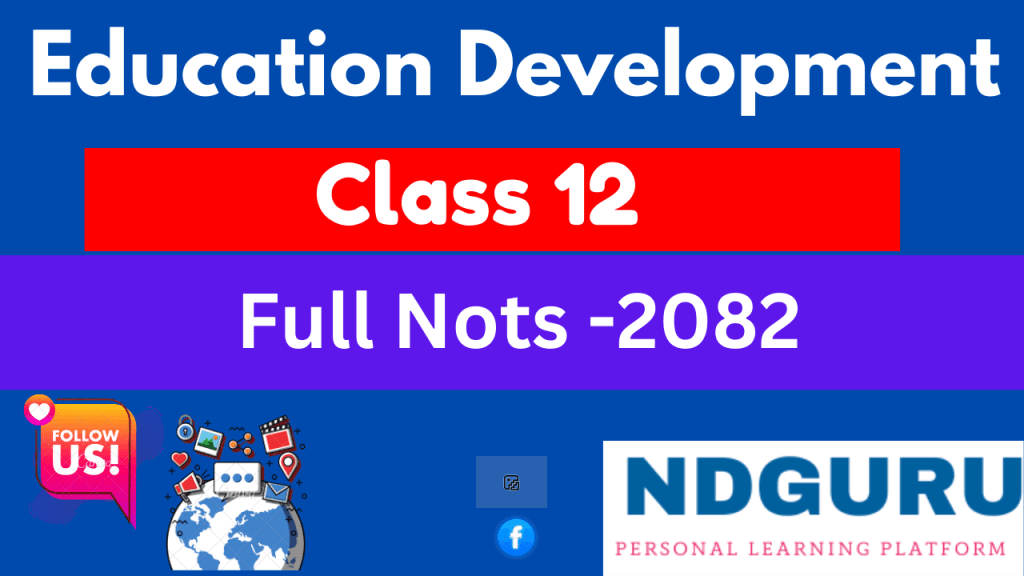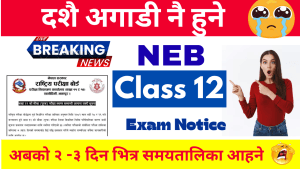NDGURU’s Ultimate Guide: Class 12 Education and Development Notes | NEB 2082 Model Questions, Summaries & Tips to Score 90+
Hey Class 12 warriors! Are you prepping for your NEB Grade 12 Education and Development exam in 2082? As Nepal’s trusted education hub, NDGURU is here to make your life easier with FREE, comprehensive notes tailored to the latest CDC syllabus. This subject isn’t just about theory—it’s the key to understanding how education drives Nepal’s growth, from community schools to national policies.
Whether you’re in Science, Management, or Education stream, this guide covers everything: chapter summaries, key concepts, model questions (updated for 2082), and pro tips to ace your boards. Download our PDF notes at the end—crafted by top educators for quick revision and full marks!
Why NDGURU? We’ve helped 50K+ students crush their exams with simple, Nepali-English bilingual notes. Let’s dive in!

Class 12 Education & Development Model Question 2082
Chapter-Wise Notes: Quick & Exam-Focused Summaries
Education and Development (NEB Class 12) focuses on education’s role in socio-economic progress. Key themes: Access, equity, investment, and community involvement. Based on the 2080/81 textbook—here’s your bite-sized breakdown:
Chapter 1: Concept of Education and Development
- Core Idea: Education = Human Capital. It boosts productivity, reduces poverty, and fuels GDP growth (e.g., Nepal’s literacy rate jumped from 54% in 2001 to 71% in 2021).
- Key Terms:
- Human Development Index (HDI): Measures life expectancy, education, and income. Nepal’s HDI: 0.602 (medium category).
- Sustainable Development Goal 4 (SDG4): Universal quality education by 2030.
- Nepal Context: Post-2015 earthquake, education enrollment rose 15% via scholarships.
- Exam Tip: Link education to SDGs—expect 5-mark questions!
Chapter 2: Education System in Nepal
- Structure: Formal (school-college), Non-formal (literacy classes), Informal (family learning).
- Challenges: Urban-rural gap (rural dropout: 20%), gender disparity (girls’ enrollment: 92% vs. boys’ 95%).
- Reforms: School Sector Development Plan (SSDP) 2016-2023—free textbooks, midday meals.
- Stats: 7.5 million students; 35K schools. Goal: 100% literacy by 2030.
- Quick Fact: Nepal’s education budget: 13% of total (aligns with global 20% target).
Chapter 3: Sources of Educational Investment
- Sources:
- Government: 70% funding (MoEST budget: NPR 200B in 2081).
- Private Sector: 25% (e.g., private schools in Kathmandu Valley).
- Community/International Aid: 5% (UNICEF, World Bank grants).
- ROI of Education: Every year of schooling adds 10% to income (World Bank data).
- Nepal Example: Flash Report I & II for school monitoring.
- Tip: Draw a pie chart for sources—great for 10-mark visuals!
Chapter 4: People’s Participation in Education
- Meaning: Community ownership for better outcomes (e.g., SMC—School Management Committees).
- Measures to Promote:
- PTA meetings & local fundraising.
- Inclusive policies for Dalit/Janajati.
- Digital tools like E-Paath for remote areas.
- Benefits: Reduces absenteeism by 30%; boosts retention.
- Case Study: Bhaktapur’s community schools—enrollment up 25%.
Chapter 5: Diversity Management in Classroom
- Types of Diversity: Ethnic (125 castes), Linguistic (123 languages), Socio-economic.
- Strategies:
- Inclusive teaching (multilingual resources).
- Anti-discrimination policies (per Constitution 2072).
- Teacher training on equity.
- Goal: Zero tolerance for bias; promote cultural festivals in schools.
- Exam Hack: Use real-life examples like Madhesi inclusion post-2072.
Chapter 6: Compulsory Education & Resources for School Development
- Mandatory Conditions: Free & compulsory up to Grade 8 (Constitution Art. 31).
- Infrastructure, trained teachers, safe environment.
- Community Resources: Local donations, alumni networks, eco-friendly projects.
- Challenges: Resource crunch in hills (only 60% schools have labs).
Chapter 7: Global Trends in Education & Development
- Trends: Digital learning (post-COVID boom), Vocational Ed (TVET in Nepal).
- Comparisons: Nepal vs. India/Bangladesh—Nepal lags in GER (Gross Enrollment Ratio: 98% secondary).
- Future: NEP 2076 emphasizes tech & equity.
Pro Revision Tip: Use mind maps for chapters 3-5. Revise stats—they’re gold for long answers!
Key Concepts Table: At-a-Glance Revision
| Concept | Definition | Nepal Example | Exam Weightage |
|---|---|---|---|
| Human Capital | Skills/knowledge enhancing productivity | SSDP scholarships | 10 marks |
| Equity in Education | Equal access regardless of gender/caste | Gender parity in enrollment | 8 marks |
| Investment Sources | Funding from govt/private/community | MoEST budget NPR 200B | 12 marks |
| People’s Participation | Community involvement in planning/monitoring | SMCs in rural schools | 15 marks |
| Diversity Management | Handling cultural/linguistic differences | Multilingual textbooks | 10 marks |
| SDG4 | Quality education for all by 2030 | Nepal’s 71% literacy rate | 5 marks |
NEB 2082 Model Questions with Answers (Updated!)
Group A: Short Answers (1×11=11 marks)
- Define HDI. (Ans: Composite index of health, education, income.)
- List 2 sources of educational investment. (Ans: Govt. budget, NGOs.)
- What is people’s participation? (Ans: Active community role in education.) … (Full set in PDF—11 Qs covering all chapters.)
Group B: Brief Answers (5×6=30 marks)
- Explain diversity management strategies. (Ans: Inclusive curriculum, teacher sensitization—150 words.)
- Discuss compulsory education conditions. (Ans: Free access, infrastructure—link to Art. 31.)
Group C: Long Answers (10×3=30 marks)
- Elaborate sources of investment & their role in Nepal’s development. (Ans: Detailed with stats, pie chart suggestion.)
- Suggest 4 measures for people’s participation. (Ans: PTA, local funds, monitoring committees, awareness campaigns.)
- How does education drive sustainable development? (Ans: Via HDI, SDGs—Nepal case studies.)
Full Model Paper PDF: Download below—solved with marking scheme!
Scoring Hack: Practice 3 past papers. Focus on 15-mark Qs—they’re application-based!
Pro Tips to Hit #1 in Your Class
- Daily Routine: 1 hr notes + 30 min model Qs. Use NDGURU YouTube for video explanations.
- Common Mistakes to Avoid: Forgetting Nepal-specific stats—memorize 5 key ones!
- Resources: Pair with textbook + our bilingual notes. Join NDGURU Telegram for doubt-clearing.
- Motivation: Education isn’t just marks—it’s your ticket to changing Nepal!
Struggling? DM us on Instagram @ndguru_np or join our Rs.100/subject online classes for live mocks.
Download FREE PDF Notes + Model Questions: Click Here (Bilingual, 50+ pages, printable).
Tag a friend who needs this! Share if it helped. #NDGURU #Class12Notes #EducationAndDevelopment #NEB2082 #NepalEducation #ScoreHigh
What’s your biggest exam worry? Comment below—we reply FAST!
Posted by NDGURU – Your Personal Teaching Guru | Empowering Nepal’s Future





 NEB-2082
NEB-2082